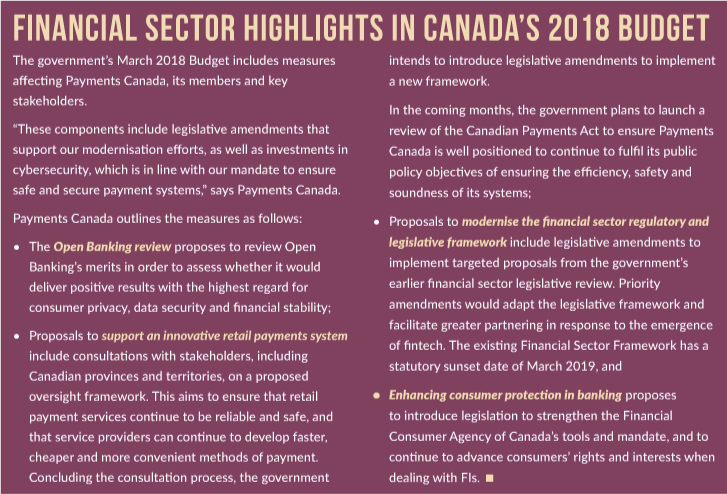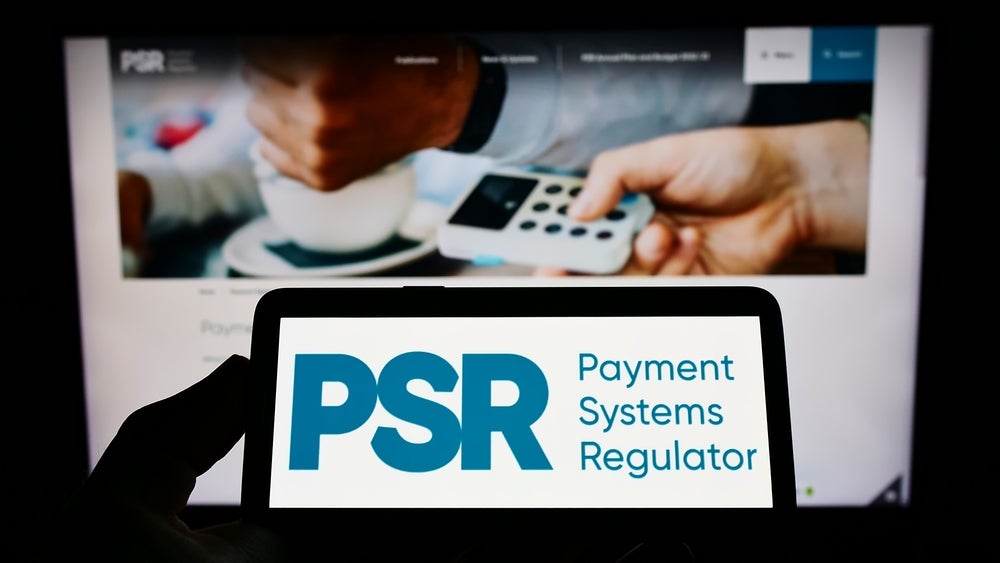Payments Canada’s national payments infrastructure modernisation programme has moved from planning to implementation. In March 2018, the organisation implemented a credit risk model, and this autumn it will enhance Canada’s electronic funds transfer system. It has also completed a detailed consultation with members and stakeholders about the new payment systems envisaged in its modernisation target end state. Robin Arnfield reports
Operating under an Act of Parliament, Payments Canada manages Canada’s core payments infrastructure.
This includes the Automated Clearing Settlement System (ACSS), a batch-based retail system processing 28 million transactions a day between Canadian financial institutions (FIs), and the Large Value Transfer System (LVTS) real-time wire transfer system.
According to Payments Canada’s 2017 Canadian Payment Methods and Trends report, in 2016, the total Canadian payments market accounted for 21.3 billion consumer and business transactions worth over C$9.2trn ($7.24trn). In 2016, the electronic funds transfer (EFT) transaction value outgrew the cheque value for the first time, while online banking transfers were up by nearly 51% to reach C$68bn.
“In 2016, a major payment industry milestone was reached as EFT grew to become the largest instrument in terms of transaction value (45.4%), moving paper-based payments to second place,” the report notes.
“EFT includes electronic bill payments, pre-authorised debits and direct deposits, which have combined to provide alternatives for transactions that had traditionally been cheque-intensive.”
How well do you really know your competitors?
Access the most comprehensive Company Profiles on the market, powered by GlobalData. Save hours of research. Gain competitive edge.

Thank you!
Your download email will arrive shortly
Not ready to buy yet? Download a free sample
We are confident about the unique quality of our Company Profiles. However, we want you to make the most beneficial decision for your business, so we offer a free sample that you can download by submitting the below form
By GlobalDataLong process
Payments Canada originally embarked on consultations and planning for its modernisation programme nearly 10 years ago. Its credit risk model is a significant milestone en route to the development of a new payments infrastructure offering data-rich real-time clearing and settling of payments based on ISO 20022.
“The introduction of a credit risk model means the ACSS will be aligned with international best practices and risk management standards,” Payments Canada says. “The Interim Credit Risk Model will see system participants pledging collateral to cover the risk they bring to the system.”
The ACSS clears the vast majority of Canadian electronic and cheque payments. It is used by participant FIs – ‘direct clearers’ – which handle payments clearing and settlement for their own customers, as well as for customers who maintain accounts at other FIs, known as ‘indirect clearers’.
The LVTS supports settlement of other payment networks and financial market infrastructures, which include final settlement of the ACSS. Payments Canada also operates the US Dollar Bulk Exchange system for payment items in US dollars, drawn on US dollar accounts at FIs in Canada but settled in the US.
Credit risk
The central Bank of Canada has designated the ACSS as a prominent payments system, which requires more stringent risk-management criteria to be implemented.
A Payments Canada paper, A Primer on Credit Risk in Payments Canada’s Automated Clearing Settlement System, examines the magnitude of credit exposure when direct clearers default.
The paper notes that credit risk exists in the ACSS, as a survivors-pay loss-allocation mechanism is embedded directly into the system’s rules.
Reviewing the last 10 years of daily ACSS data and simulating many thousands of potential defaults, Neville Arjani, the paper’s author, found that the largest exposure was over C$500m for one ACSS participant.
“For a large bank, that’s most likely manageable when the economy is stable. Trying to secure C$500m in a crisis like the one being contemplated in the paper may be more difficult,” the paper notes.
Modernisation end state
In December 2017, Payments Canada published The Modernisation Target State (summary version), which outlines the target end state for the modernisation of the Canadian payment system, including core infrastructure, rules and standards.
The target state comprises three new systems, which will operate under an enhanced risk, regulatory and rules framework – balancing the need for safety and soundness with accessibility to spur innovation, Payments Canada says.
“Fundamental to each system is the introduction of the ISO 20022 payment messaging standard, which enables the flow of more data with payments,” it says.
Lynx
Canada’s new Lynx system will replace the LVTS, and will comply with the Bank of Canada’s risk-management standards for systemically important payment systems.
Retail clearing
Also referred to as Settlement Optimisation Engine (SOE), this system will replace the existing ACSS and US Dollar Bulk Exchange platforms.
It will clear retail batch payments and comply with the Bank of Canada’s risk management standards for prominent payment systems. It will enable faster, more convenient Automated Funds Transfers (AFTs), a Canadian payment mechanism used for payroll, bill and mortgage payments, and other electronic funds transfers.
Real-time rail (RTP)
This new, always-on payments infrastructure will support immediate payments and funds transfers. As a platform for future innovation, it will enable payment system participants to provide overlay services offering new ways to pay for goods and services and transfer money.
Payments Canada also plans several short-term deliverables, including enhancements to the Automated Funds Transfer system. In autumn 2018, two-hour funds availability for AFTs will come into effect, enabling same-day payroll, expedited bill payments and faster invoice settlement.
Speaking to Jan Pilbauer, Payments Canada’s CIO and executive director for modernisation, EPI asks whether new federal regulations will be required to facilitate the RTR, for example to open it up to non-banks providing overlay services.
“The need for more open, risk-based access to facilitate competition and innovation was one of the key findings of our vision consultation [with stakeholders],” Pilbauer replies.
“Payments Canada’s enabling legislation defines who can be a member, and therefore a participant, in our systems. As part of our modernisation programme, we’re working with the [Federal Government’s] Department of Finance, the Bank of Canada, our members and our stakeholders to review access to Canada’s core payments systems, including the RTR, with a view to providing risk-based open access beyond our current mandate.
“Our modernisation target state is to have Phase 1 of Lynx live in 2020, followed by future releases from 2021 onwards,” Pilbauer continues. “The RTR is expected to go live in the latter half of 2019, with supplementary releases to follow in 2020 and beyond.
“We’re in the planning stages for the retail batch payment system which will replace the ACSS and US Dollar Bulk Exchange. This is a collaborative effort with the Bank of Canada and our member FIs to align the solution and the timeline with regulatory and market priorities, including the delivery of Lynx and the RTR.”
Pilbauer adds: “Meanwhile, we’re enhancing the existing system to deliver immediate market value. This includes implementing a new credit risk model to align the ACSS with international best practices and risk-management standards, and improvements to Automated Funds Transfer this autumn to bring faster, more convenient batch payments to Canadian businesses.
“The AFT improvements will be achieved by introducing a third time of day for FIs to exchange batch payments, and new obligations to provide funds availability within two hours.
“These changes will help FIs clear transactions faster and more frequently for their customers, enabling new features like same-day payroll, expedited bill payments, faster invoice settlement, the migration from paper and cheque payments, and more uniform service across all Canadian time zones. All these enhancements support our target modernisation end state, and will be reflected in the new system.”
Blockchain
Payments Canada is collaborating with financial blockchain technology vendor R3 on a distributed ledger technology (DLT) research project code-named Jasper. The project’s other participants are the Bank of Canada, CIBC, TD, Scotiabank, BMO Bank of Montreal, Royal Bank of Canada and HSBC Bank Canada.
“Project Jasper was launched in March 2016 to better understand how DLT could transform the future of payments in Canada,” Andrew McCormack, Payments Canada’s senior director of technology, tells EPI. “In the first two phases, the project focused on exploring the clearing and settlement of high-value interbank payments using DLT.
“During the first phase, a distributed ledger prototype was built to investigate the use of a central bank-issued inter-bank settlement token – this essentially acted as cash,” McCormack says. “At the end of the second phase in May 2017, we concluded that, while blockchain has immense potential, it doesn’t yet provide an overall net benefit relative to our current centralised systems.
“Phase II’s findings included acknowledging that enterprise blockchain platforms like R3’s Corda have made significant advances in terms of privacy and confidentiality, security, scalability and programmability.”
“Project Jasper’s third phase involves Payments Canada working with the Bank of Canada and Canadian financial markets operator TMX Group to expand the DLT proof of concept to include securities clearing and settlement. The project team is building an integrated financial market infrastructure in order to reduce equity trade settlement from days to minutes, and optimise the collateral requirements for market participants.”
McCormack continues: “Project Jasper examines wholesale clearing and settlement use cases for DLT. As Payments Canada operates in the wholesale [payments] space, we’re looking at whether DLT meets our needs, from a technology perspective, in terms of accomplishing the wholesale clearing and settlement services we offer.
“We’re asking whether there are new or better ways to manage our processes and can we leverage DLT. We’re taking a utilitarian view of what DLT could do for us. TMX’s financial markets infrastructure involves derivatives and equities clearing and settlement, and we run the clearing and settlement of payments.
“In Project Jasper’s third phase, we bring these two infrastructures together theoretically to see if we can make inter-bank processes less costly and more efficient – for example, reducing the time involved in clearing equities from T+2. We’ve engaged with several commercial banks to review the technology and business implications of what we’ve been discussing.”
McCormack adds: “Payments Canada’s mandate from parliament comprises setting payments industry rules and policies, operating wholesale services such as wire transfer services and clearing and settlement, and innovation and facilitating industry discussions. So, experimenting with DLT within Project Jasper is a perfect fit with our innovation mandate. DLT has been a great catalyst for industry-wide collaboration.
“We aim to make an announcement at our May 2018 Payments Canada Summit in Toronto about the findings and discussion points from Project Jasper’s third phase. Shortly afterwards, we hope to release a white paper about the third phase.”
During the May 2018 Payments Canada SUMMIT, Payments Canada announced the findings from Project Jasper’s third phase. In a statement, it said the third phase demonstrated that the instantaneous clearing and settlement of securities on-ledger is feasible, showing for the first time that both central bank cash and assets can be tokenized to complete an instant, end-to-end equity settlement on DLT. A white paper about the third phase will be published later this year.
“This proof of concept shows that it is possible to deliver payments in a way that has never been done before – by directly swapping cash from buyers to sellers, resulting in instant settlements,” said Gerry Gaetz, President and CEO of Payments Canada. “We continue to see how the application of distributed ledger technology can help extend the vision of payments innovation in Canada and potentially, one day, help promote financial market integration, both nationally and internationally.”
Stakeholder comments
In February 2018, Payments Canada completed its Modernisation Target State public consultation. Payments Canada says the consultation validated support for some key elements outlined in the target state, while raising several considerations.
“Feedback was shared about allowing the highest level of access to each system [offered in the target state] by giving FI members equitable access to the exchange, clearing and settlement functions, as a means to enable firms to grow without having to rely on their direct competitors’ services,” it reads.
Payments Canada says there is “support for a risk-based approach to broadening access, with the requirement that risk tests adopted equally apply to all participants as the most effective way of preserving the payments infrastructure’s overall safety, soundness and security”.
Stakeholders agreed that the RTR has the potential to serve as a platform for innovation, and that access needs to be balanced with prudent risk management.
“There is a desire for conditions that consider fairness and transparency for non- FIs to support levelling the playing field to encourage inclusion and competition between new entrants, incumbents, and potential new entrants,” Payments Canada says.
Analyst comments
“Payments Canada’s goal is to open up real-time payments so you can just send money to someone via their email address or mobile number,” says Christie Christelis, president of Canadian payments consultancy Technology Strategies International.
“But, because a lot of stages have to take place in the modernisation programme, this won’t happen quickly.”
Christelis says one issue is that Canada’s B2B payments are still heavily cheque-based. “Improving the Automated Funds Transfer system will really help to put an end to business cheques,” he says.
Another issue is that providing overlay payment services on faster payment rails would require Canadian banks to open up their APIs. “The Canadian Government wants banks to open up their APIs,” he says (see below). “But I think Canadian banks may not be that keen, as they feel threatened by open APIs and they will still have to bear the burden of regulatory compliance. So I think it will be a long time before we see open APIs becoming a reality in Canada.”
Christelis notes that some banks will be more advanced than others in offering open APIs and Open Banking. One example is RBC which, in March 2018, became the first Canadian bank to launch its own API developers’ portal.
“The RBC developers’ portal will allow eligible, external software developers, industry innovators and clients to access select RBC APIs,” RBC says.









